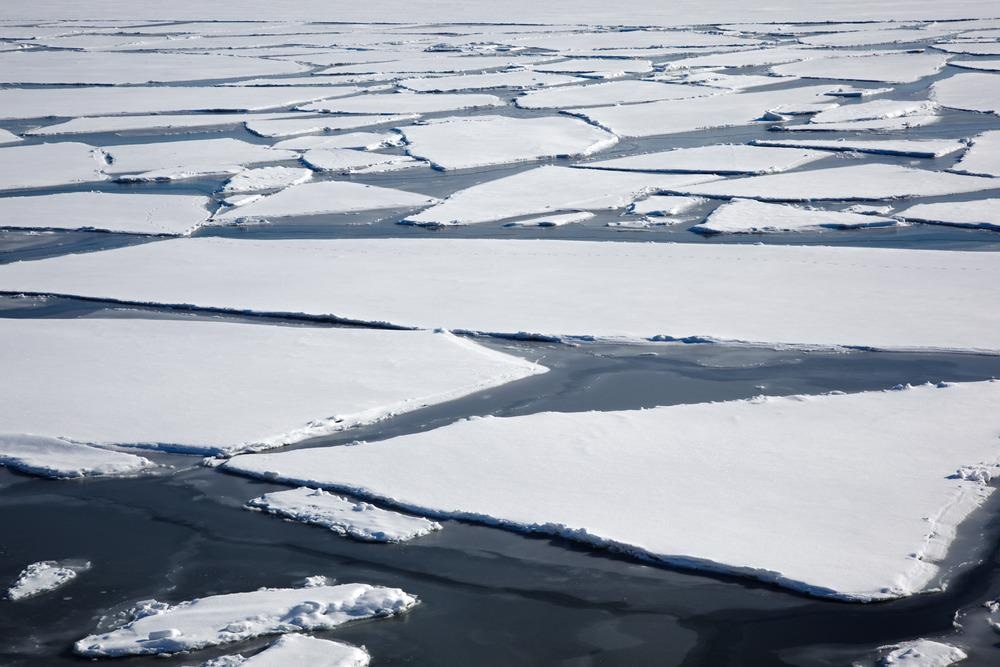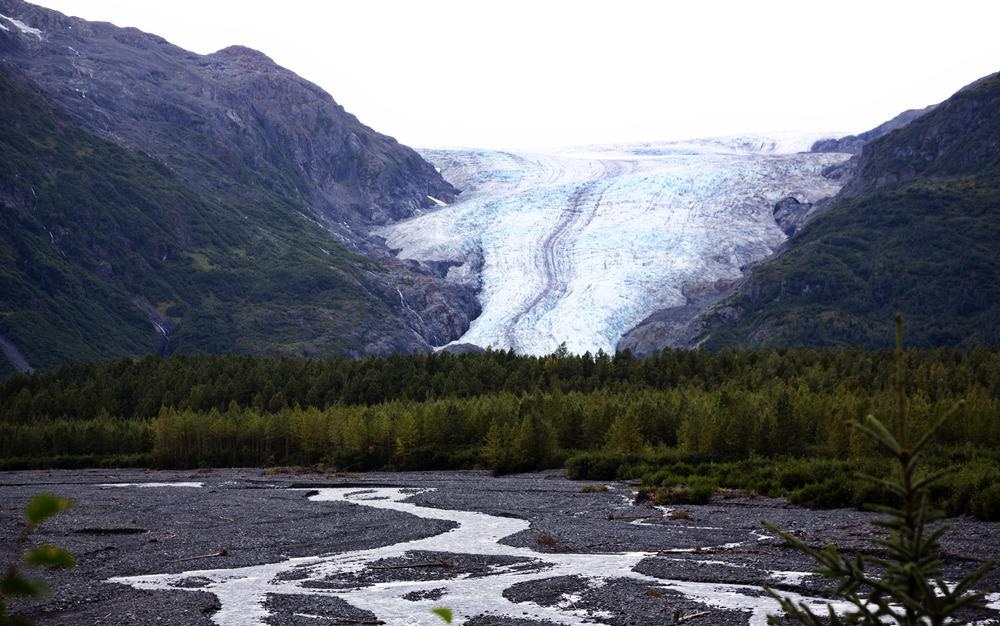Ice sheets can be incredibly mobile masses in our oceans. During the yearly ice melts, which have significant seasonal patterns in the Arctic region, regions of ice commonly break off and are carried across the oceans by their currents.

Ice sheets are made from frozen water and are a vital part of the Earth’s carbon cycle.1 They are host to vast amounts of organic matter and can help transport this to different regions as part of their global journeys. The 2021 Intergovernmental Panel on Climate Change (IPCC) report has highlighted the rate of rapid ice sheet loss, particularly in Greenland, is highly likely to continue.2 Part of the overall loss of ice sheet mass could result in losses in ice sheet stability and higher mobility.
There are several current methods used to track ice sheet movement. However, this process can be challenging as slow-moving glaciers may only move by centimeters at a time. Satellite data is commonly used, but seismographic information can also help as large tremors indicate a large amount of movement in the ice. Still, as different glaciers have different types of movement patterns, the corresponding seismic events can be very weak and difficult to detect.
Fiber optic-based methods may be a better approach to tracking ice sheet movement. Recent work has made use of fiber-optic distributed temperature sensing to understand the thermodynamic behavior of a glacier in Greeland.3 Using this technology, the research team could understand some of the mechanical stresses different regions of the glacier were under and constructed a complex profile of the entire behavior pattern of this fast-moving glacier.

Image Credit: vrihu/Shutterstock.com
Fiber-Optic Distributed Temperature Sensing
Distributed temperature sensing networks can extend over several kilometers, often using the Raman effect to provide continuous temperature profiles along the entire length of the fiber-optic cable. A laser pulse is sent through the cable to perform measurements, and the intensity of the scattered anti-Stoke Raman signal is measured relative to the Stokes signal. As the strength of the anti-Stokes feature is proportional to the temperature, and the Stokes scattering is relatively constant, the relative changes in the anti-Stokes intensity can be correlated with temperature change along the fiber optic cable. Adaptations can be made to monitor strain information as well.
The team used a distributed temperature sensing system inserted into a borehole. This allowed for a significantly better vertical resolution in the sampling than had been achieved in previous studies using discrete temperature sensor set-ups.3 The researchers have revealed the complexity of modeling needed for understanding ice rheology.
In a borehole, the ice is formed in various layers. Often, the deepest layers will correspond to the oldest ice, which may exceed a thousand years in age. Ice of different ages will have been formed under varying environmental conditions and have variable microscopic structures and mechanical properties.
Fiber-optic approaches make it possible to investigate several kilometers of a borehole and simultaneously monitor these different layers and their individual behavior. Collecting all of these temperature measurements is what allowed the team to provide critical, new data on potential limits of ice viscosity and the thermodynamic processes occurring within the glacier.3
The Future of Fiber Optics for Climate Change Monitoring
As identified in the IPCC 2018 report, accurate and meaningful climate models are one of the most important tools we have in predicting, and therefore mitigating, the effects of climate change.4 However, many of these models involve vastly complex problems such as glaciers, inherently multi-component systems with different layers exhibiting different behaviors.
Developments in distributed temperature sensing networks have made it possible to acquire new, high-quality data with excellent profiling of a 1 km length of a borehole for 40 days.3 This data is vital to verify and test models that can then be used to identify vulnerable areas in glaciers. Countries like Switzerland are already trying to take preventative measures to slow glacier loss. By covering at-risk regions in blankets, and more accurate modeling of thermodynamic behavior, more accurate risk assessments of glacier stability can be obtained. Ultimately, this can help identify where such interventions may be most effective.5

Image Credit: Florence-Joseph McGinn/Shutterstock.com
Fiber-optic distributed temperature sensing networks are excellent tools for monitoring remote and hard-to-access regions, such as off-shore infrastructure or where very high spatial resolution of temperature information is required. While one of the challenges the research team faced was a failure past 889 m which limited the amount of information that could be acquired, more robust technologies for fiber optics are continually developed.3
Drilling boreholes is another logistical challenge for many glaciers, yet the amount of detail in temperature profiling that could be performed will open up many new opportunities. Advancements in our understanding of the thermodynamic properties and movement of ice sheets, even for the slightest changes, can be achieved.
--
Industrial Response to Climate Change
This article is a part of the IPCC Editorial Series: Industrial Response to Climate Change, a collection of content exploring how different sectors are responding to issues highlighted within the IPCC 2018 and 2021 reports. Here, Optics showcases the research institutions, industrial organizations, and innovative technologies driving adaptive solutions to mitigate climate change.
References and Further Reading
Wadham, J. L., et al. (2019) Ice sheets matter for the global carbon cycle. Nature Communications, 10(1). Available at: https://doi.org/10.1038/s41467-019-11394-4
IPCC, (2021) Summary for Policymakers. In: Climate Change 2021: The Physical Science Basis. Contribution of Working Group I to the Sixth Assessment Report of the Intergovernmental Panel on Climate Change [Masson-Delmotte, V., P. Zhai, A. Pirani, S. L. Connors, C. Péan, S. Berger, N. Caud, Y. Chen, L. Goldfarb, M. I. Gomis, M. Huang, K. Leitzell, E. Lonnoy, J.B.R. Matthews, T. K. Maycock, T. Waterfield, O. Yelekçi, R. Yu and B. Zhou (eds.)]. Cambridge University Press. In Press.
Law, R., et al. (2021) Thermodynamics of a fast-moving Greenlandic outlet glacier revealed by fiber-optic distributed temperature sensing. Science Advances, 7(20), 1–12. Available at: https://doi.org/10.1126/sciadv.abe7136
IPCC, (2018) Summary for Policymakers. In: Global Warming of 1.5°C. An IPCC Special Report on the impacts of global warming of 1.5°C above pre-industrial levels and related global greenhouse gas emission pathways, in the context of strengthening the global response to the threat of climate change, sustainable development, and efforts to eradicate poverty [Masson-Delmotte, V., P. Zhai, H.-O. Pörtner, D. Roberts, J. Skea, P.R. Shukla, A. Pirani, W. Moufouma-Okia, C. Péan, R. Pidcock, S. Connors, J.B.R. Matthews, Y. Chen, X. Zhou, M.I. Gomis, E. Lonnoy, T. Maycock, M. Tignor, and T. Waterfield (eds.)]. World Meteorological Organization, Geneva, Switzerland. In Press
Rosane, O., (2021) Swiss Resort Uses Blankets to Keep Glacier Cool. [online] EcoWatch. Available at: https://www.ecowatch.com/glacier-melting-switzerland-blankets-protection-2654842780.html
Disclaimer: The views expressed here are those of the author expressed in their private capacity and do not necessarily represent the views of AZoM.com Limited T/A AZoNetwork the owner and operator of this website. This disclaimer forms part of the Terms and conditions of use of this website.